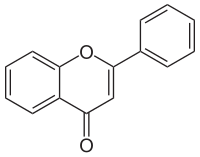
Photo from wikipedia
Ester derivatives of epigallocatechin gallate (EGCG) were enzymatically prepared by one-step transesterification with vinyl fatty acids consisting of varying acyl groups ranging from 2 to 18 carbon atoms (acetate, butyrate,… Click to show full abstract
Ester derivatives of epigallocatechin gallate (EGCG) were enzymatically prepared by one-step transesterification with vinyl fatty acids consisting of varying acyl groups ranging from 2 to 18 carbon atoms (acetate, butyrate, caproate, caprylate, caprate, laurate, myristate, and stearate). The main acylation products were EGCG monoesters and diesters. However, due to the presence of trace amounts of water in the reaction medium, minor but noticeable hydrolysis of EGCG also occurred as a side reaction which required a prolonged purification process due to the formation of by-products such as gallic acid, epigallocatechin, and their esters. In this contribution, 8 EGCG monoesters, 7 EGCG diesters, and 7 gallic acid monoesters were isolated and purified, and the acylation positions were characterized. Meanwhile, several classical chemicals (DPPH, ABTS, FRAP, and Fe2+ chelation assays), food (β-carotene bleaching assay), and biological (LDL and DNA oxidation assays) models were conducted to evaluate and systematically compare their antioxidant efficacy. The lipophilicity of the EGCG derivatives increased with the increasing chain length of the acyl group and led to the fluctuation of their antioxidant efficacies. Three main factors, namely, the reduction potential, the partition coefficient of solute in the solvent system, and the steric hindrance of antioxidant agent and related substrates were considered to help explain the biased antioxidant performance of EGCG derivatives upon acylation modification. The results strongly suggest that the acylated EGCGs have great potential as lipophilic alternatives to the water-soluble EGCG in lipid-based matrices.
Journal Title: Journal of agricultural and food chemistry
Year Published: 2022
Link to full text (if available)
Share on Social Media: Sign Up to like & get
recommendations!